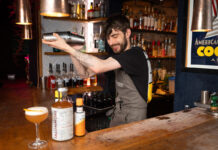Beer and cider drinkers expected to prioritise quality going forward

THIS year’s lockdown period is likely to have had an impact on the beers and ciders customers will purchase this autumn – with a freshly-poured pint once again seen as a treat.
Both categories are hugely important to bars and pubs, with figures from Heineken claiming on-trade beer sales reached £12.8 billion in the UK last year (£1bn in Scotland) and cider accounting for £2bn.
And while the figures are bound to look different in 2020, it’s clear that beer and cider are cornerstones of the on-trade experience with consumers expected to prioritise quality when heading out to bars and pubs.
“People are more likely to want to treat themselves and will be willing to pay a bit more when they go out, so look at how you can make the most of this with a range of more premium options,” said Andrew Lawrence of Molson Coors.
Rob Sandall of Thatchers Cider agreed.
He said the lockdown period “had a significant impact on consumer choice”.
“For a regular pub-goer who has a naturally limited choice of beer and cider, during lockdown the off-trade represented a chance to reappraise the category and choose the brands that met their needs the most,” said Sandall.
Stephen Kofler of Krombacher reckoned the lockdown has seen expectations rise with “consumers having more time on their hands and showing a few more discerning drinking habits”.
The trend towards ‘premiumisation’ isn’t new, of course. Consumers have been increasingly turning to more premium products for several years now.
And Jerry Shedden of Heineken said at the heart of the trend is “an ever-more knowledgeable and demanding consumer who is increasingly willing to trade up their drinks choices”.
“In fact, 47% of consumers are willing to pay more for a better quality drink,” said Shedden.
Craft beer has been one of the beneficiaries of the trend towards more premium products, and Shedden said this has been reflected in craft beers being stocked by around 35% of outlets across the UK, with a quarter of customers said to be more likely to visit a venue if it stocks a range of craft beers.
However, operators were warned against removing mainstream brands from the bar as established favourites are likely to continue to be popular as well.
“Repeat trade is going to be more important than ever and, while many consumers will want to treat themselves with something a bit special after so long away from their local, others will be hankering for their regular draught favourite, so considering the right balance across your range will be crucial,” said Lawrence at Molson Coors.
This is just as true of the cider category, which is said to have performed particularly strongly during the lockdown period.
Rob Salvesen of Kopparberg said: “Cider saw a massive resurgence during this period, with cider growing the fastest at 49% and fruit cider specifically at 73%.
“The only category showing greater growth is in premixed spirits, as consumers understandably look for ways to recreate an in-bar experience at home.
“As the on-trade begins to open its doors, we expect consumers to continue to buy into the categories and, more importantly, the brands they have been enjoying in their own homes.”
Draught has long been king in the on-trade for both beer and cider and this isn’t likely to change anytime soon. However, drinks companies advised using fridge space to stock a selection of craft beers and more exotic fruit ciders.
“Consumers are willing to sample new products in packaged format, which means there’s more opportunity for you to experiment, such as by introducing exotic flavours,” said Shedden at Heineken.
“With tap space becoming increasingly limited, this allows outlets to maintain throughput and quality with mainstream draught cider options, while offering choice and premiumisation through pack-aged cider.”
With venues discouraged from having customers stand at the bar, those packaged products will be even less visible than usual, however, and companies stressed how important it is that venues are able to communicate their full range of beers and ciders to customers.
“People are navigating the on-trade differently and brand communication definitely isn’t now all about that few seconds at the bar when the pressure is on to make the call,” said Simon George of Budweiser Budvar.
Collette Cumbes of cider maker Celtic Marches encouraged operators to make full use of digital marketing – websites, social media channels and apps – to make their range as visible as possible.
“Having menus with images can help but for ease, utilising online platforms can help customers make decisions prior to arrival and access to imagery simpler on site,” said Cumbes.
Salvesen of Kopparberg said making menus available for customers to peruse at their tables rather than the normal “panic ordering at the bar” will lead to customers “taking their time to pick out their favourite brands and drinks”.
And with table service the standard in licensed premises for the foreseeable future due to COVID-19, staff have the opportunity to encourage customers to trade up.
“To make the most of this, it’s important customer-facing employees really get to know the beers and ciders behind the bar and become comfortable chatting with customers about the line-up,” said Martyn Jones of Westons Cider.
“While the fixture itself might be temporarily less visible, if the team is confident and clear on the choice available, this shouldn’t need to negatively impact sales.”



















